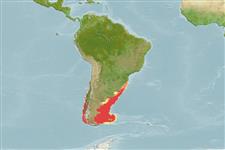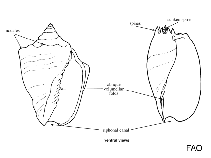Adelomelon ancilla (Lightfoot, 1786)
Ancilla volute| Native range | All suitable habitat | Point map | Year 2050 |

|
| This map was computer-generated and has not yet been reviewed. |
| Adelomelon ancilla AquaMaps Data sources: GBIF OBIS |
Upload your photos
Google image | No image available for this species;
drawing shows typical species in Volutidae.
Google image | No image available for this species;
drawing shows typical species in Volutidae.
Classification / Names Common names | Synonyms | CoL | ITIS | WoRMS
Gastropoda | Neogastropoda | Volutidae
Environment: milieu / climate zone / depth range / distribution range Ecology
Benthic; depth range 10 - 600 m (Ref. 87801). Tropical; 29°S - 54°S, 77°W - 46°W (Ref. 83435)
Distribution Countries | FAO areas | Ecosystems | Occurrences | Introductions
Southeast Pacific and Southwest Atlantic. Tropical to temperate.
Length at first maturity / Size / Weight / Age
Maturity: Lm ? range ? - ? cm Max length : 21.0 cm DL male/unsexed; (Ref. 83435)
In shallow water near the shore, inhabiting mixed gravel and sand bottoms, (Ref. 106093). It is found on rocky bottoms with cobbles and shells from depths of 10 to 600 m (Ref. 87801). Infaunal (Ref. 106093). Usually carries on its shell the anemone Antholoba achates, which also lives attached to hard substrates within the same area. Feeds mainly on bivalves and secondarily on gastropods (Ref. 106092). Captures live prey by tightly engulfing it with the foot (Ref. 106093).
Life cycle and mating behavior Maturity | Reproduction | Spawning | Eggs | Fecundity | Larvae
The spawn consists of a single large ovate egg which is attached to the substrate. There are 2 to 8 embryos that develop within the capsule and it emerges as crawling juveniles. Direct development.
Main reference
References | Coordinator | Collaborators
Rosenberg, G. 2009. (Ref. 83435)
IUCN Red List Status (Ref. 130435)
CITES status (Ref. 108899)
Not Evaluated
CMS (Ref. 116361)
Not Evaluated
Threat to humans
Human uses
| FishSource |
Tools
More information
Age/Size
Growth
Length-weight
Length-length
Morphology
Larvae
Abundance
Growth
Length-weight
Length-length
Morphology
Larvae
Abundance
Internet sources
BHL | BOLD Systems | CISTI | DiscoverLife | FAO(Publication : search) | Fishipedia | GenBank (genome, nucleotide) | GloBI | Gomexsi | Google Books | Google Scholar | Google | PubMed | Tree of Life | Wikipedia (Go, Search) | Zoological Record
Estimates based on models
Preferred temperature
(Ref. 115969): 4.5 - 10.5, mean 6.7 (based on 324 cells).
Price category
(Ref. 80766):
Unknown.



